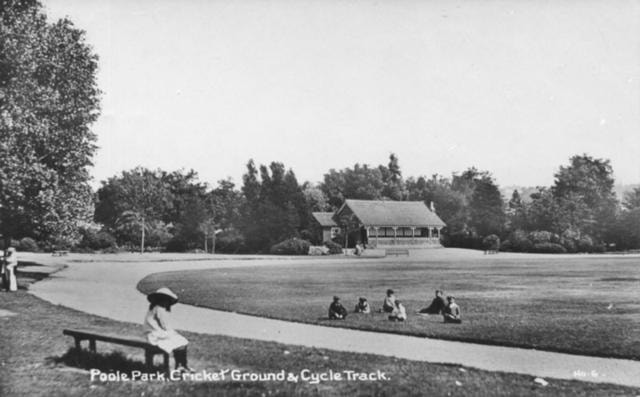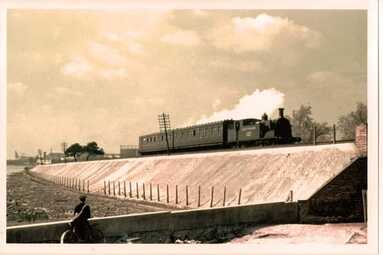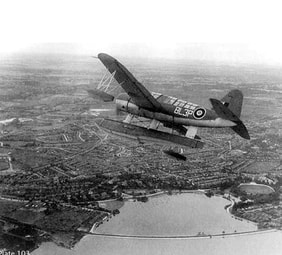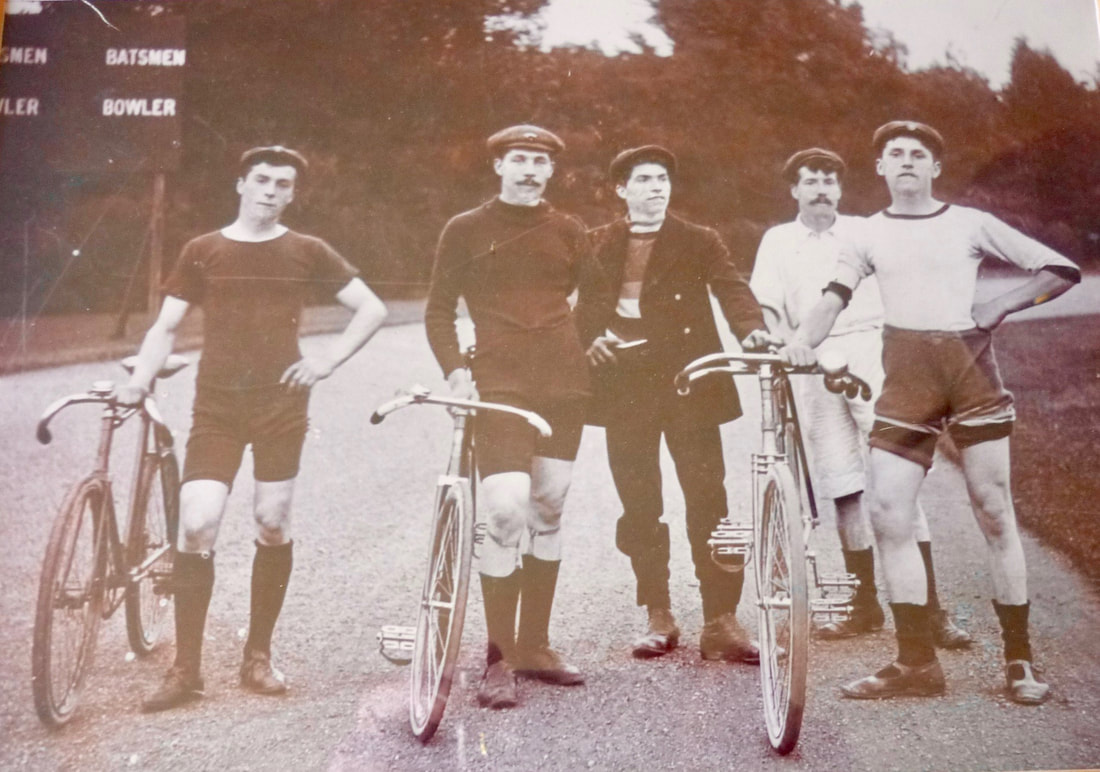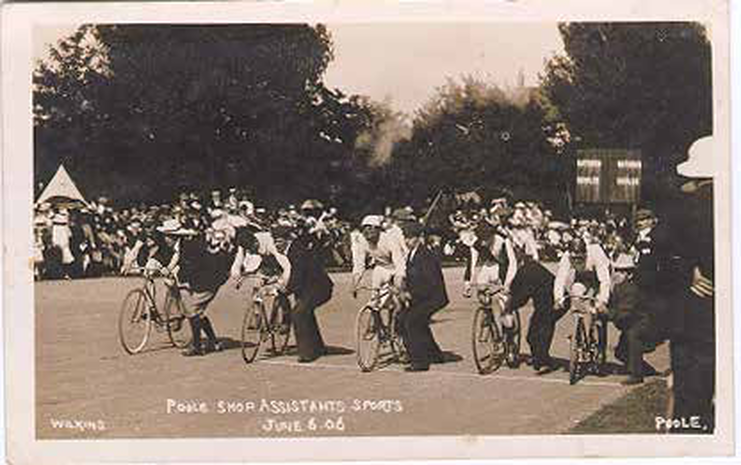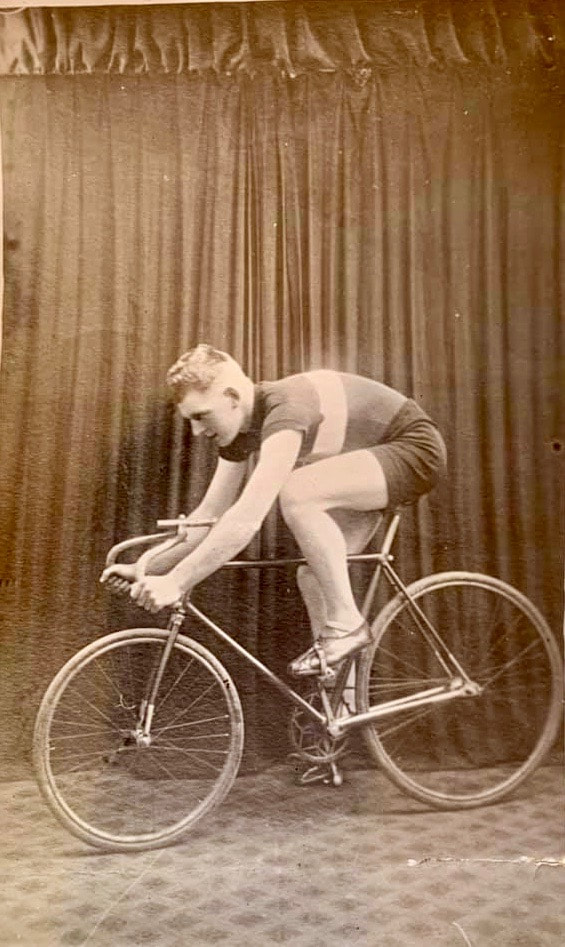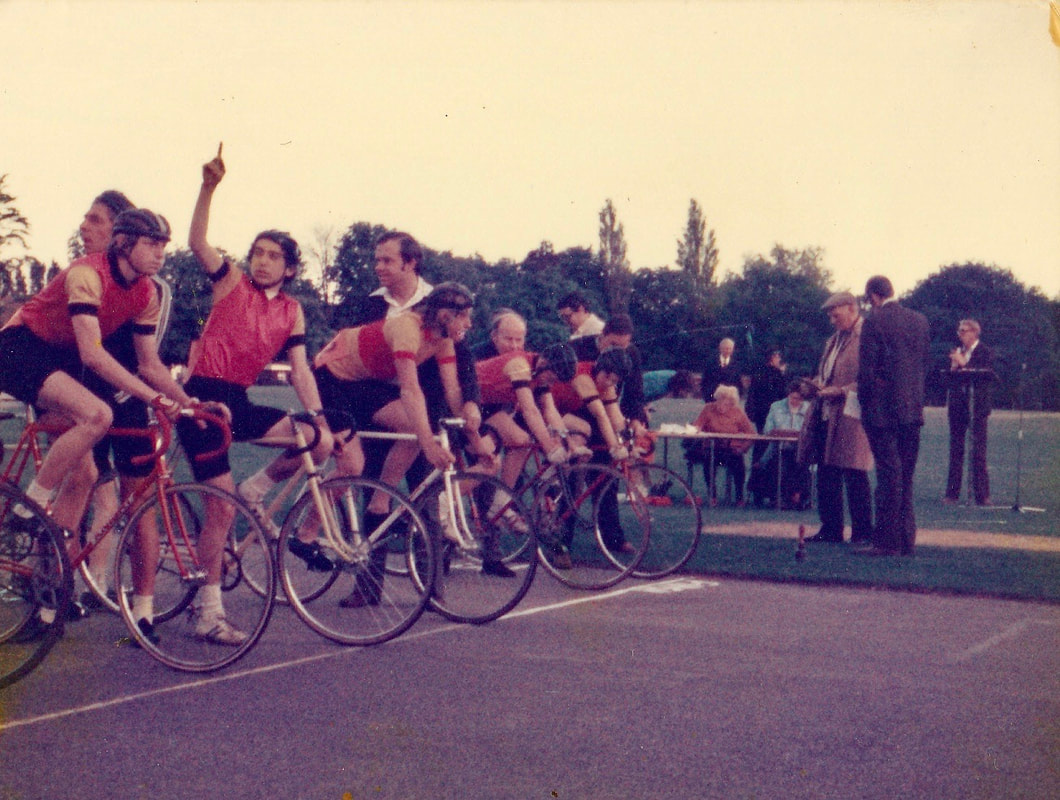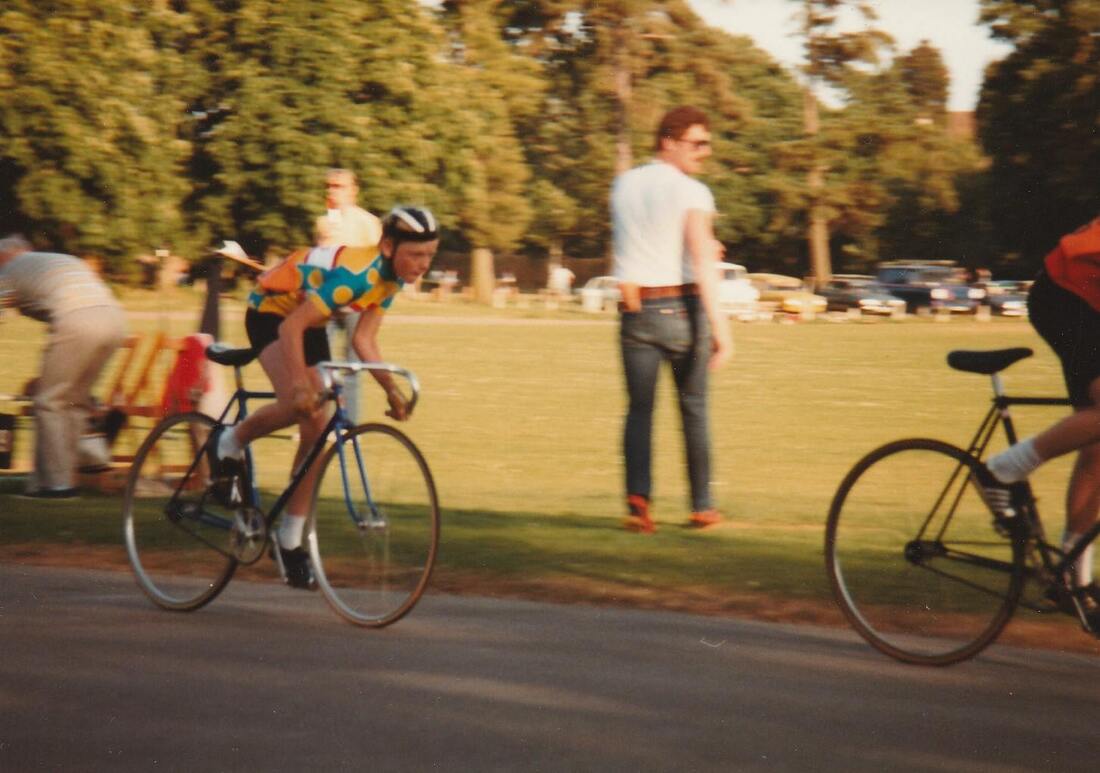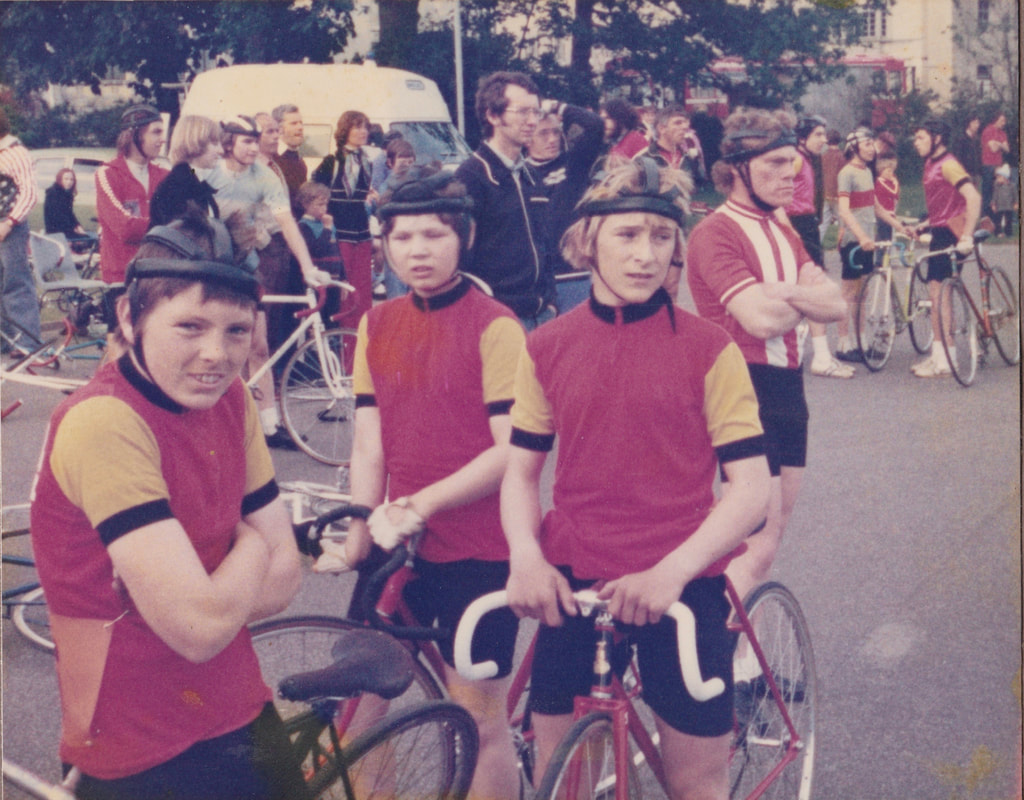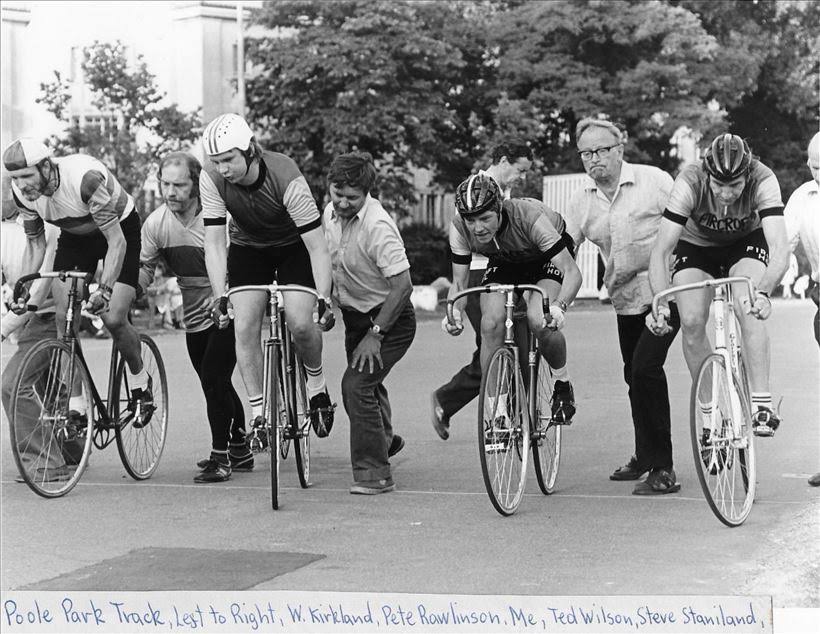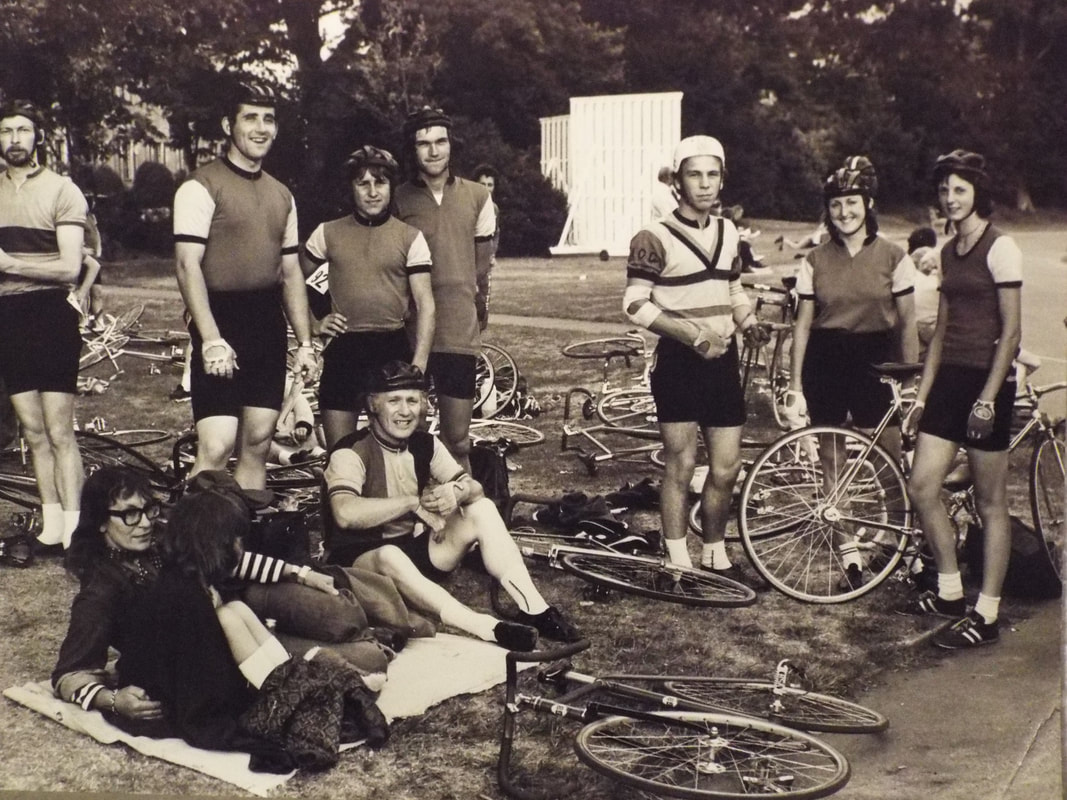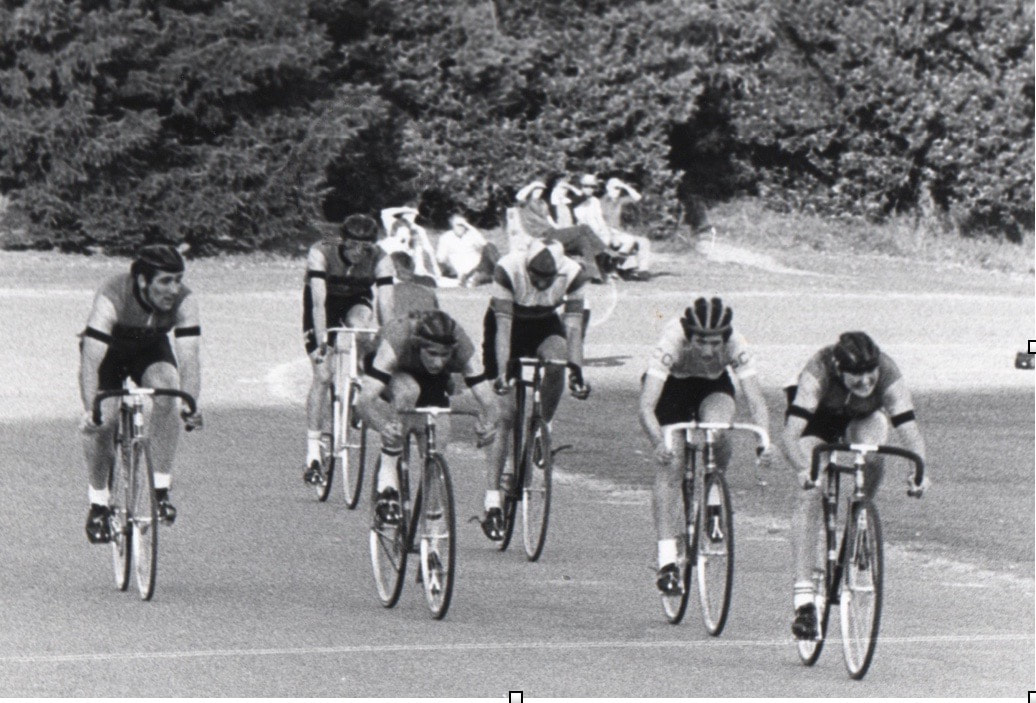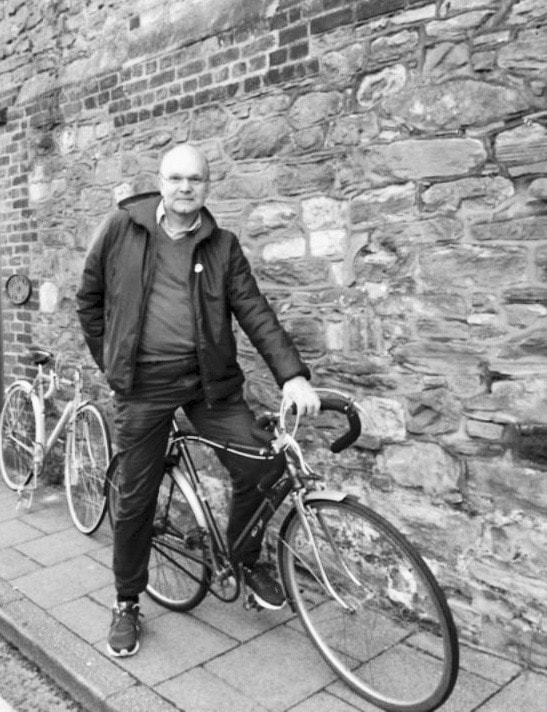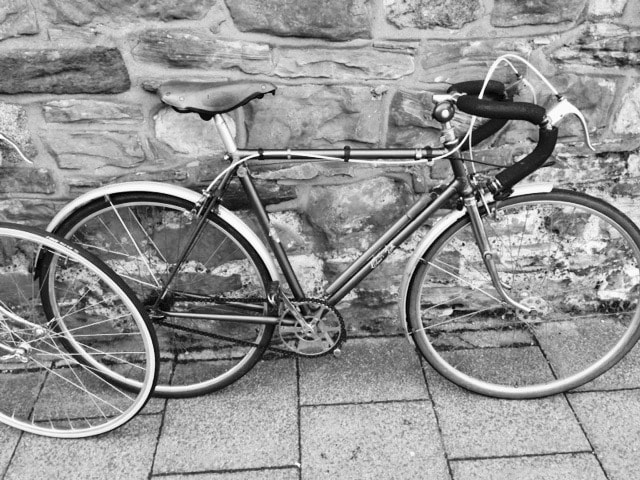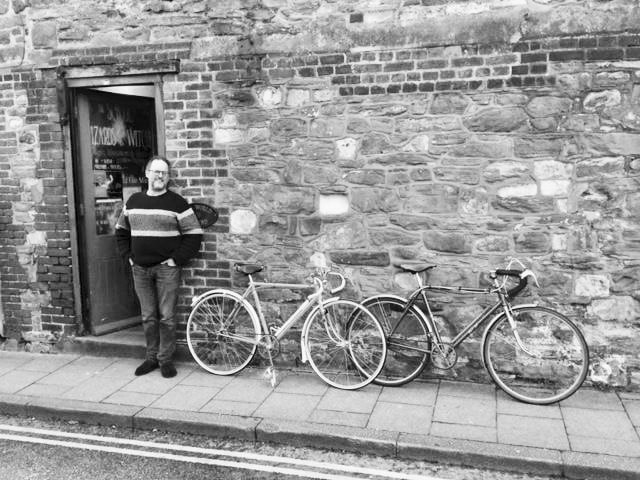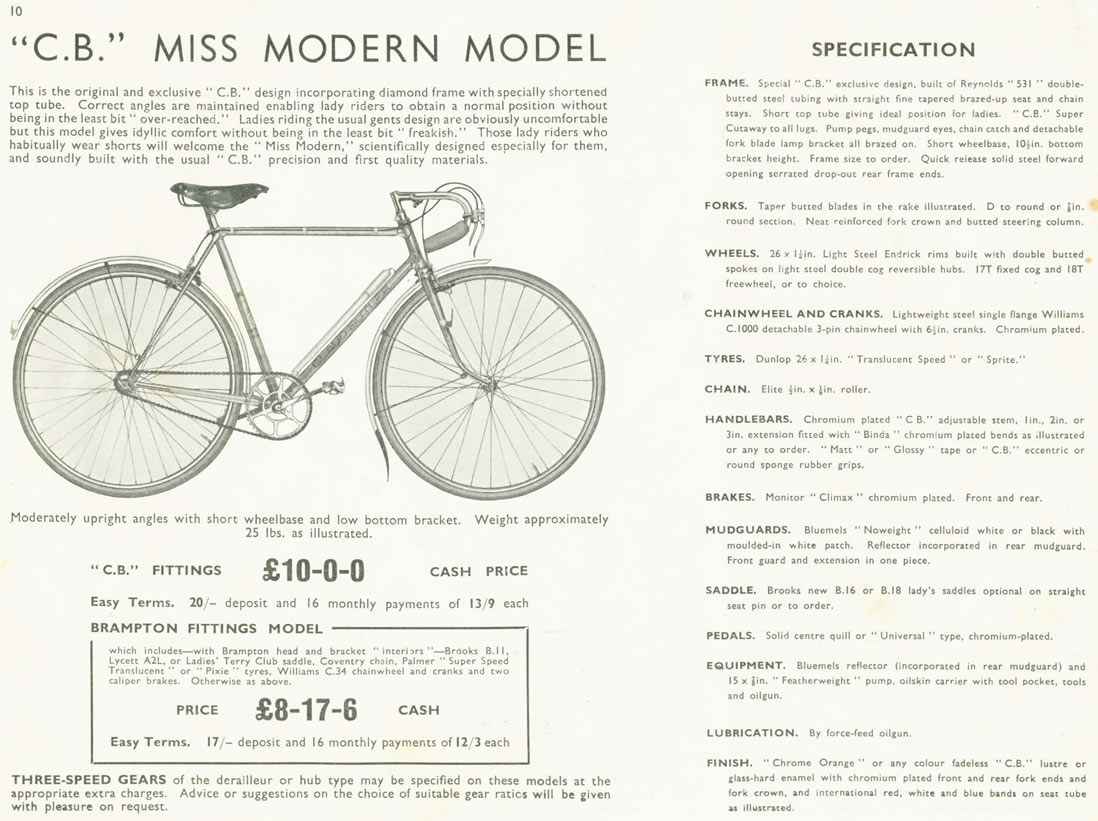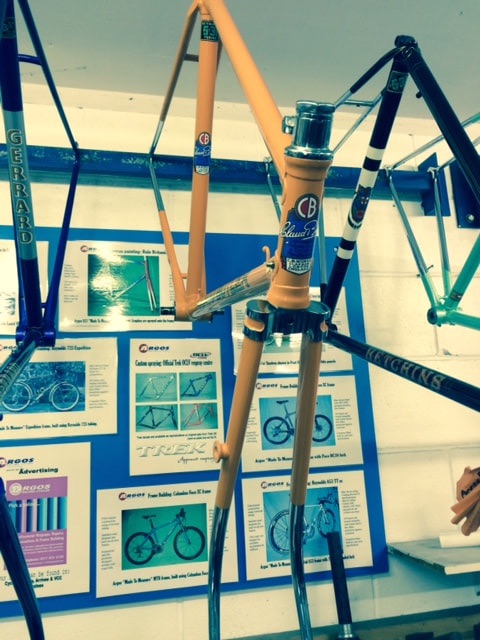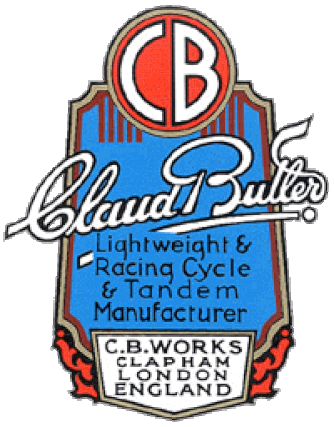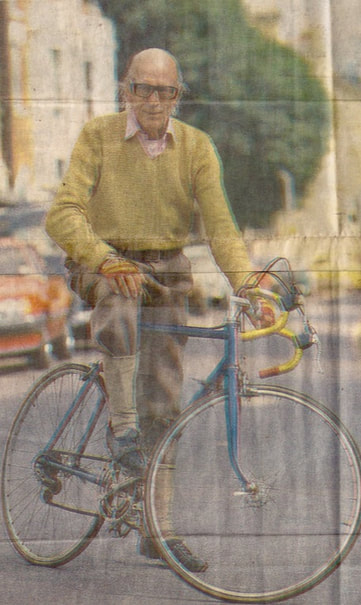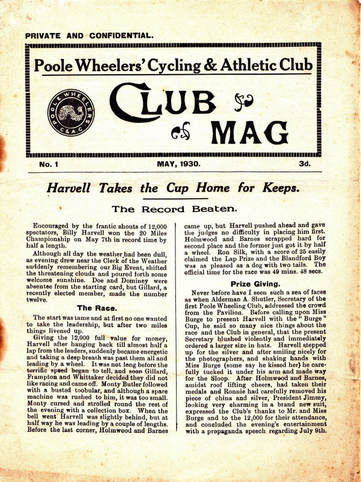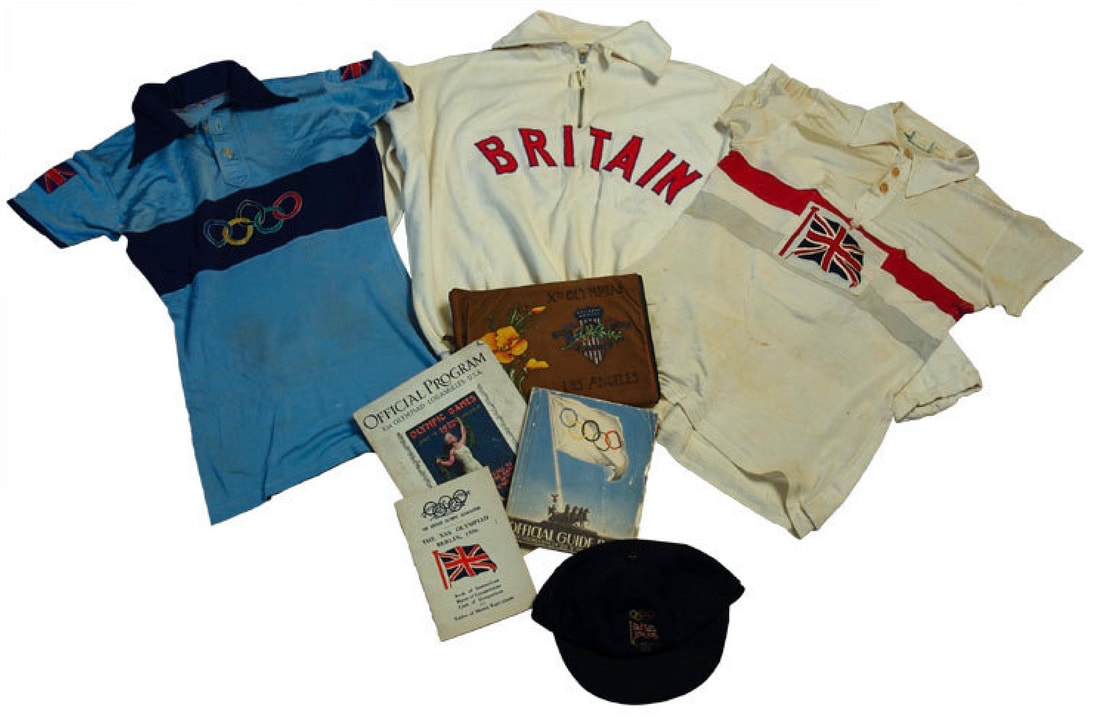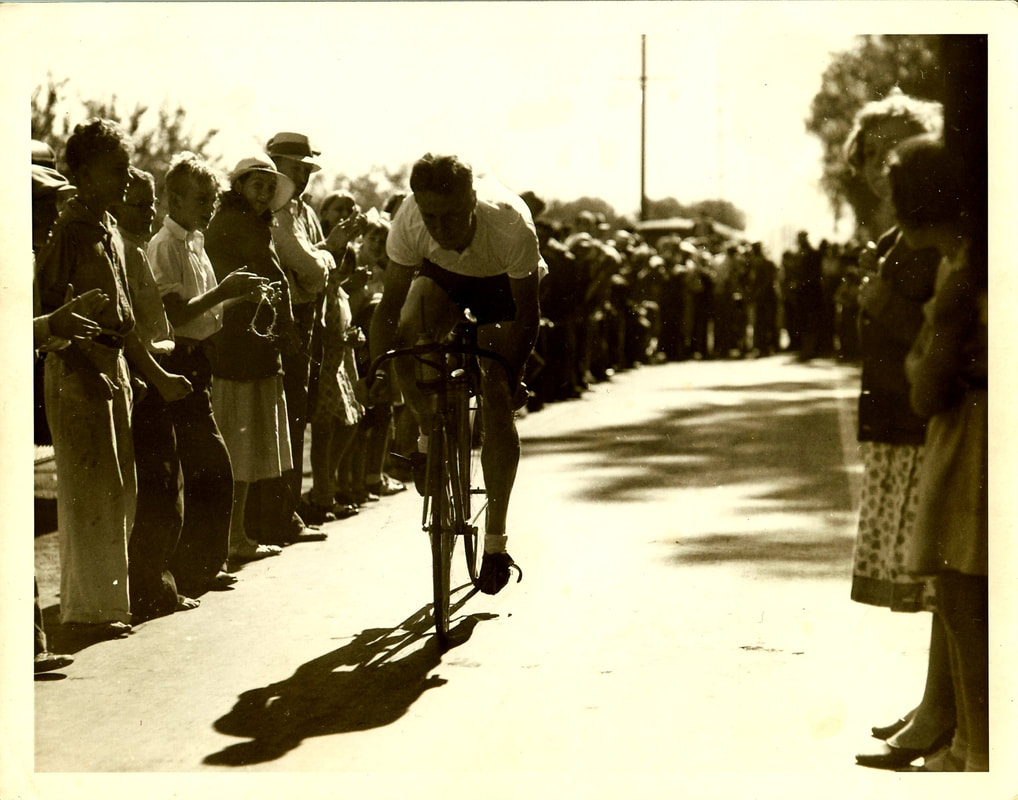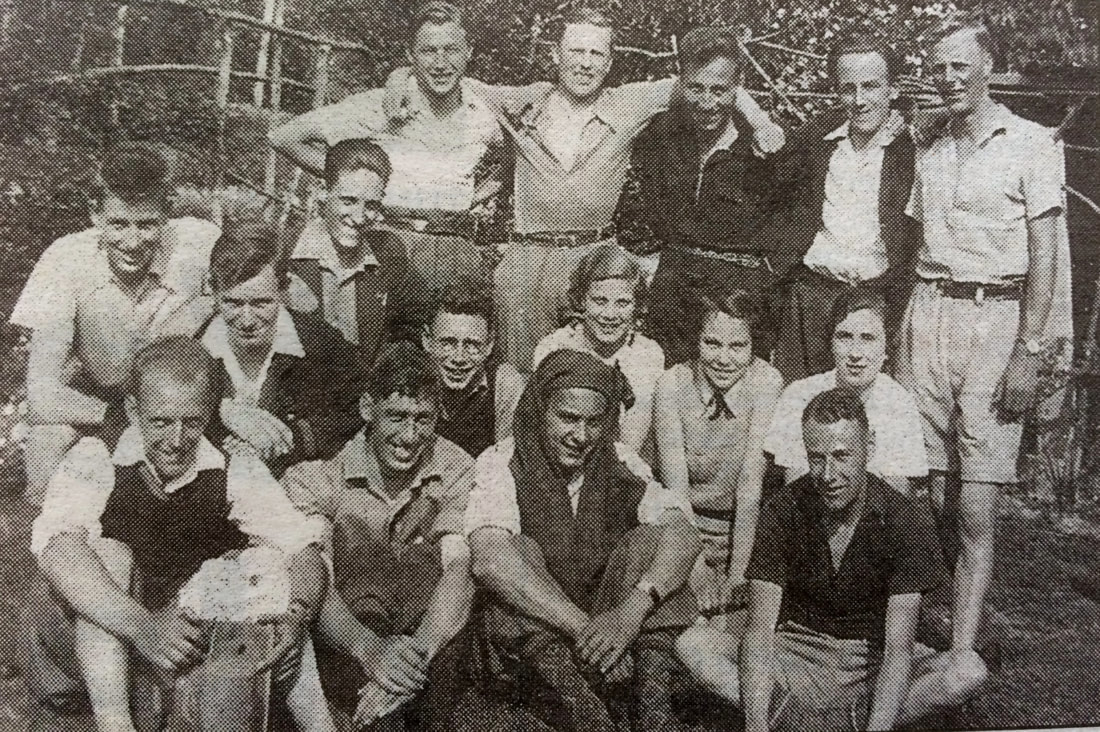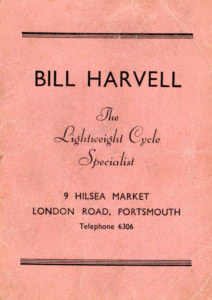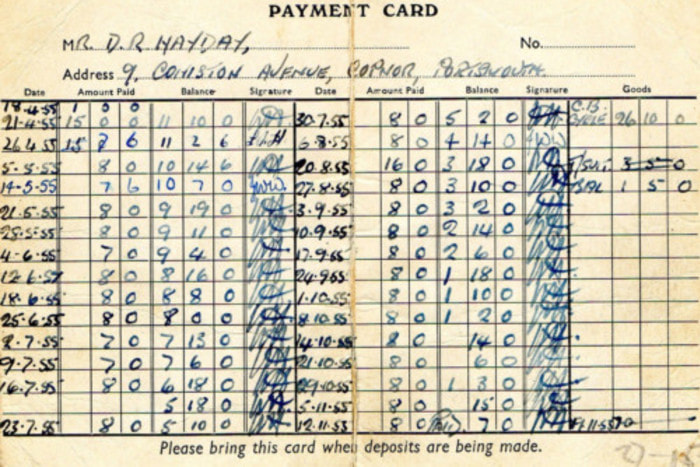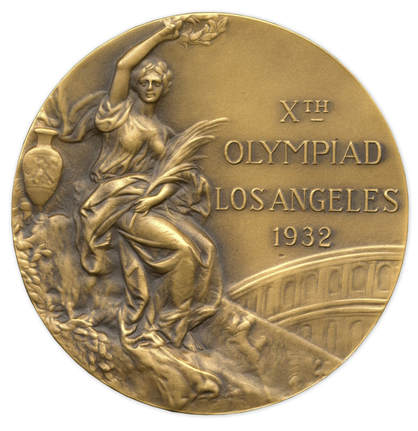Poole Park TrackI grew up in the 70s, we lived right beside Poole Park so much of my childhood was spent playing there. We just took it for granted, but now looking back and learning about its creation I realise how lucky I was to have free range over this Victorian creation. Many long summer evenings were spent watching the the cycling at Poole Track. My elder brother, Tom, raced for Bournemouth Arrow (Marguerite's Club) and cut his competitive teeth here. Riders would travel quite a distance to compete, and local clubs included Poole Wheelers, Bournemouth Arrow, Bournemouth Jubilee, Crabwood and The Wessex Road Club. I remember the atmosphere building as riders and their supporters met up, standing amongst a sea of bikes laid on the ground in front of the Cricket Pavilion; the 'pssssst' hiss as the track pumps were released from tyre valves; the very tall commentator Mr Moss calling for the crowd to stand back from the track. The star riders from the time I remember as a ten year old boy were Steve Moss who would always be the scratch rider in the handicap sprint, easily overhauling the field. George Dixon was the class act in the group races. I particularly remember him riding a low-pro track bike - something very new at the time. Our family building company J.H.Wilson & Sons even sponsored a meeting in about 1978. 1887- 1892THE CREATION OF POOLE PARK. The Railway came to Poole via Parkstone in 1872. A rail causeway cut across Parkstone Bay from Whitecliff to just north of Bator. This resulted in a landlocked brackish water lake with marsh and reed beds. In 1885 the landowner, Lord Wimborne, donated the land to the Borough for the creation of a Peoples Park and Recreation ground. A competition was held for the design of the Park and was won by Elford. A cricket pitch enclosed by a circular bicycle track formed the principle feature of Elford's scheme for the park (plan 1887). The Park was officially opened 1890 but the cricket ground and cycle track were not completed until 1892.  The Parkstone coast. Look carefully and you can see the Pavilion completed in 1890. The Parkstone coast. Look carefully and you can see the Pavilion completed in 1890. The Pavilion had been completed in 1890, it can be seen in the photograph of the shoreline in Parkstone Bay. And yes, the harbour came all the way to the edge of sandbanks road. Apparently the nearby Sloop public house was named after an ancient Sloop boat that was rotting away in the nearby reed beds. I presume that this area was finally drained when it was cut of from the rest of the seawater lake by a road built across the southern tip of the lake. Elford's design for the Park was a masterpiece making full use if the relatively small acreage of land that boardered the large saltwater lake. 1890sI wondered whether the cycle track was designed specifically for racing or whether it was for recreational cycling and then adopted for racing. After a little research I learned that Victorian racing tracks were a 'thing' and were typically circular or oval. Poole's track is circular and measures three laps to a mile. Further research revealed a thriving racing scene, the earliest report I found was from 1893 within the first year of the tracks opening. Poole had two main clubs in the 1890s, the Poole Wesley Guild CC founded 1890 and Poole Cycling Club. From 1895 Poole CC adopted and new name, the Poole Wheeling Club or Poole Wheelers although many stuck with the original name Poole CC . In the race report (below) from 1893, the Bantten (or Banten) family feature strongly. The family owned a Bicycle shop. Leon was their star rider, featuring in reports throughout the decade riding for the Poole Wesley Guild CC. I was interested to learn that the Poole Wesley Guild, part of the Methodist Church is still in existence. Bournemouth Guardian. 23 September 1893 THE POOLE PARK SPORTS There was a large attendance at the Poole Park Sports and Fire Brigade competitions on Wednesday afternoon, and the proceedings were of very successful and enjoyable character. ONE MILE HANDICAP BICYCLE RACE, for boys under 17. - The prizes were a medal, given by Mr C Banten; 7s6d (Poole C.C ); and 4s. The starters in this race were: A C Rogers (Wesley C.C.), scratch; C Habgood (Wesley C.C.), 10yds; M E J Pearce (Wesley C.C.), 15yds; L Banten (Wesley C.C.),15yds; A Osman (Wesley C.C.),25yds; O E Sydenhan (Poole C.C.),30yds; and M E Rogers (Wesley C.C.),60yds. Habgood got to the front early in the race, and was allowed by the others to get a good lead. Banten made his effort on the last lap, but could only make up part of the distance , and the result was: Habgood, 1 ; Banten, 2; Sydenham, 3. Time, 2 min 53 2-5th secs. THREE MILE HANDICAP. First three in each heat to compete in the final. The following were the prizes: -£1 1s, given by the Poole C.C.; 12s 6d, and 7s6d. First heat: Ten entered for this, G H Guy being on the scratch mark, and conceding starts up to 300 yards. He caught his man on the first lap, and when the bell rang came away and won with ease in 8 min 45 2-5th secs. Lawson Banten gained second place, with Baker third. The second heat produced eight starts. F W Horn was on the scratch mark, and conceded starts as Guy to the other competitors. Daniels, Habgood, and Piper came to grief early in the race, and the issue was fought out between Leon Banten, Plumley, and Horn. Banten went away when the bell rang, and won by 40 yards, in 8 min 57 3-5th secs, Horn beating Plumley by half a wheel for second place. The final in this event was a very disappointing race. The two scratch men, Guy and Horn soon caught the others, and a waiting race took place till the last lap, when the competitors went off at a tremendous pace. The following was the result: Guy, 1; Leon Banten, 2; Horn, 3. Time, 9min. 9 1-5th secs. 1906Poole Park Sports were held on Wednesday afternoons, this was the day for half day closing in Poole. I remember this from my childhood, do any shops observe this tradition today? I wonder. Large crowds were draw to attractions such as model boat racing in the lake, running races, Fire Brigade Drill Competitions and Military Bands. Proceeds often went to the towns Cornelia Hospital. Bournemouth Guardian 9th June 1906. Under circumstances probably the most favourable that have attended any sports in Poole Park, and the presence of one of the largest crowds seen in the Park, the annual meet of the Poole Shop Assistants, organised on behalf of the Poole Cornelia Hospital, came off on Wednesday afternoon. The weather was perfect and the heat was tempered by a cool breeze, refreshing both to spectators and competitors. The various races were well entered for, and some exciting sport resulted, particularly in the shop assistants' events. The recent resuscitation of the Poole Wheeling Club had the effect of bringing a larger number of local cyclists into the field than has been seen for several years, and this aided to the interest of the sports. C.B. kingsbury, of Portsmouth, attended to defend several several cycling championships held by him, but in only one case, the one mile, had he to exert himself, Richardson, of Bournemouth, running him so close that the race was the cycle event of the meeting. Follow the link below to see rare footage of a similar Athletics meeting in 1902. 1930There seems to have been a lull in racing and disappearance of formal Cycling Clubs in Poole from the time of the Great War (1914), until a revival in the 1920s. Poole Wheelers and Athletic Club was formed from informal group known variously at the Mentone Wheelers or the 'Parkstone Suicide Club' in 1926. The format of meetings remained unchanged from the 1890s. The program started with the heats of the Handicap Sprints and finished with the 20 miles scratch race, this schedule persisted into the 1970s. Below is an account of the 1930 20 mile Championship 1930 published in first edition of Poole Wheelers & AC club Magazine. 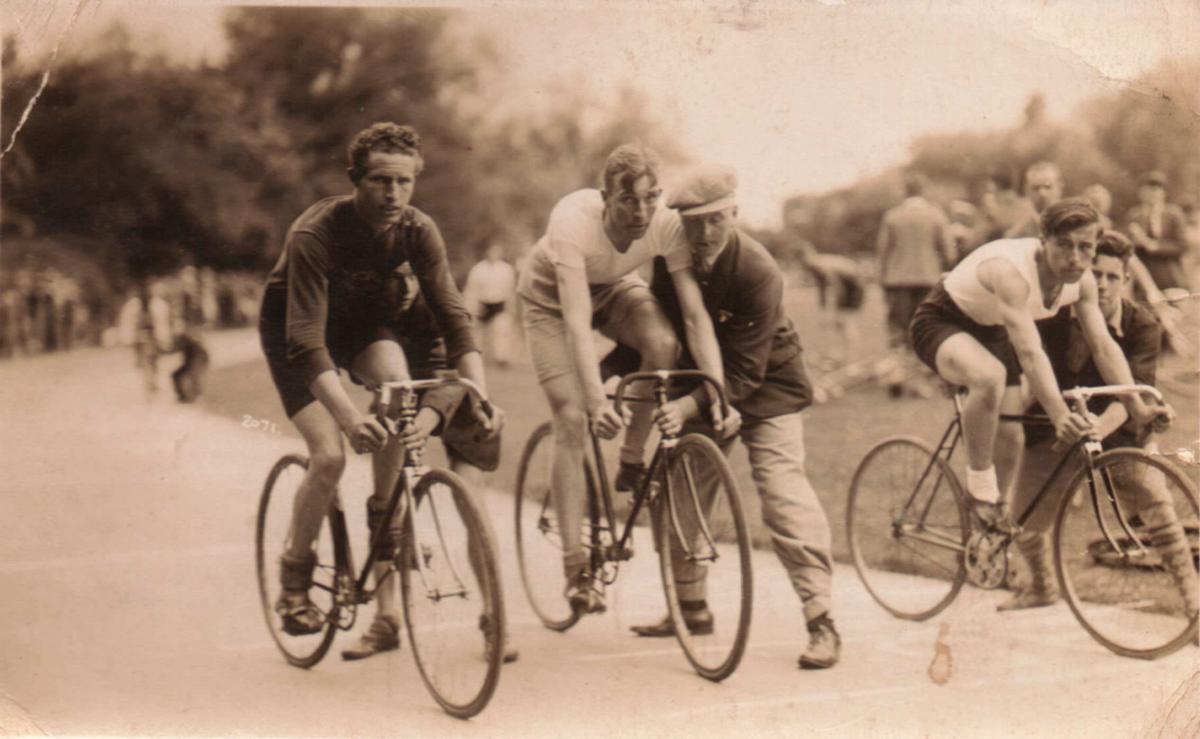 Poole Park 1930 (source - Aubrey Jenkins Poole Wheelers C & AC). Poole Park 1930 (source - Aubrey Jenkins Poole Wheelers C & AC). Poole Wheelers' Cycling & Athletics Club. Club Magazine May 1930 ‘Encouraged by the frantic shouts of 12,000 spectators, Billy Harvell won the 20 Miles Championship on May 7th in record time by half a length. Although all the weather had been dull, as evening drew near the Clerk of the Weather suddenly remembering our Big Event, shifted the threatening clouds and poured forth some welcome sunshine. Doe and Dominey were absentee from the starting card, but Gillard, a recently elected member, made the number twelve. Prize Giving. Never before have I seen such a sea of faces as when Alderman A Shutler, Secretary of the first Poole Wheeling Club, addressed the crowd from the Pavillion. Before calling upon Miss Burge to present Harvell with the ‘Burge’ Cup, he said so many nice things about the race and the club in general, that the present Secretary blushed violently and immediately ordered a larger size in hats. Harvell stepped up for the silver and after smiling nicely for the photographers, and shaking hands with Miss Burge (some say he kissed her) he carefully tucked it under his arm and made way for the Sloop. After Hollywood and Barnes, amist roof lifting cheers, had taken their piece of china and silver, President Jimmy, looking very charming in a brand new suit, expressed the Club’s thanks to Mr and Miss Burge and the 12,000 for their attendance’. 1970sSunny Evenings in Poole Park My Memories of Poole Track |
| In 1940 Marguerite signed for Claud Butler the premier Lightweight Bicycle Manufacturer. The first four of the six records set that year were on their production 'Miss Modern' Model. Three years ago a suitable 1941 Claud Butler frame came up for sale, and so began a bit of experimental archeology, a quest to make an authentic recreation of this thoroughbred road bike. Argos Racing Cycles of Bristol were the obvious choice for frame restoration. Experts in the field, the quality of their work is second to none. I enjoyed my trips up the Bristol workshop where gorgeous freshly restored frames are racked awaiting collection or dispatch to discerning owners as far afield as the USA and Japan. The Claud Butler catalogue indicated that MW's bicycle was likely to have been Chrome Orange.(a mid orange created with lead chromate and lead oxide). Reproduction decals were sourced from H. Lloyd Cycles, lacquer applied in a way that purposely toned down the paint's gloss in order to give the authentic period finish. | 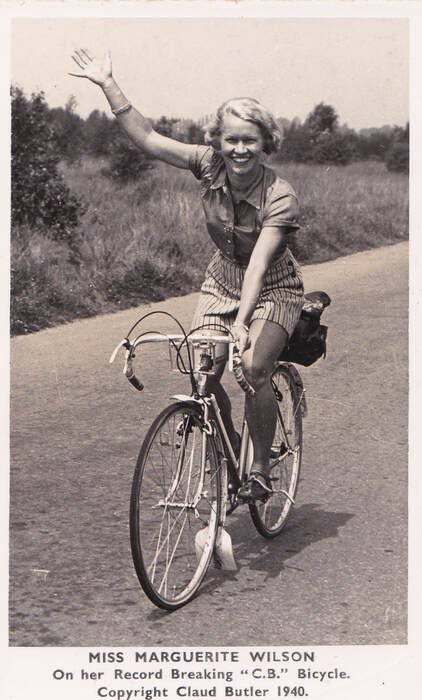 |
The Claud Butler was built by my friend George Bolton, 90 year old retired aeronautical engineer and vintage/classic bike expert. Most of the parts were sourced from e-bay and specialist dealers. Everything is correct for the bike except for a few compromises. For example, the handlebar is a new Nito track bar from Japan - it looks close the the original judged from photos.
George gave me a pair of Bluemes muguards in mint condition, probably from the 1970s but the design little changed from 1940. The same applies to the new Brooks Saddle which gives the re-creation a top dollor finishing touch.
Prestige Plating of Mexborough did the chromwork. They don't advertise, all their work comes by personal recommendation. A husband and wife team, Diane takes the calls is knowledgable and very helpful, you feel confident that she knows exactly what is needed for specific vintage parts. They re-plated the Williams chainwheel and cranks, the stem, brake levers the Chater Lee Light Bracket and some components of the Resilion brakeset.
The Webb pedals came ready restored to a high standard. They have larger than standard bearings (5/16") and an aluminium alloy centre spindle with a neat quick release dust cap.
Resilion were the brakes to have in the 1930s. Their cantilever action provided powerful stopping power, although they were complex and heavy. They are so old and complex, that I think I did well to purchase the best complete set in good condition that I could find. They do come up from time to time, but you need to avoid buying a tandem set by mistake. I avoided dismantling the cables and callipers, but was able to remove some of the brightwork for plating. Overall a good compromise I think.
The four speed Sturmey Archer hub gear was a rarity pre-war. I purchased several, often finding that what looked like a complete unit turned out to have a vital part missing. George had a complete understanding and expertise of theses hubs which proved invaluable. Perhaps one of the rarest parts was the Sturmey Archer pre-war 4-speed trigger for changing gear. Finding one at all is hard, let alone one that is in working order is hard, mine came at quite a price!
Complete, my Miss Modern re-creation looks fantastic with its chrome-work and gorgeous leather saddle. It has plenty of talking points such as the cantilever brakes, the hub gears, wing nuts for the wheels and grease nipples on headset and bottom bracket. Despite being termed a 'Lightweight', its pretty hefty to lift.
Whats next? An assessment of how it rides. I hope this will be the subject of future post. And......
STOP PRESS! A Marguerite enthusiast has contacted me, and he has the original! - watch this space.
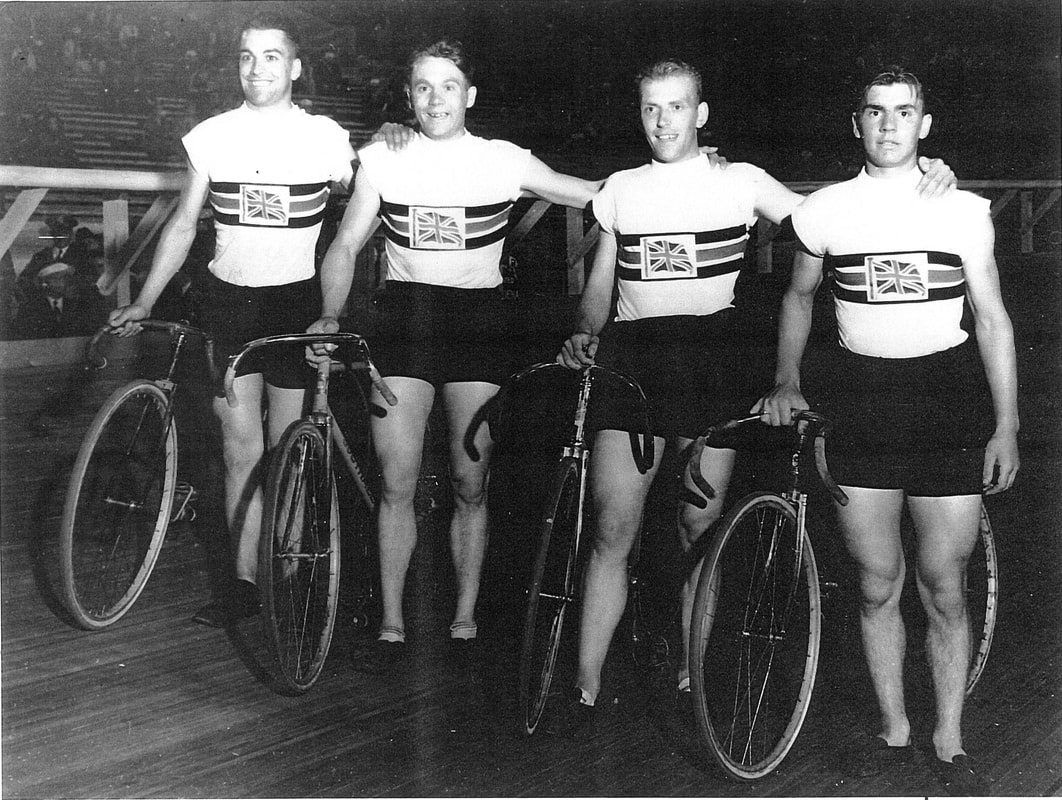
Britain's 400m Team Pursuit Team at the 1932 Los Angeles Olympic Games. From L to R - Charlie Holland, Frank Southall, Bill Harvell & Ernest Johnston. The Italians - Marco Cimatti, Paolo Pedretti, Alberto Ghilardi and Nino Borsari - won Gold medals with 4min 53s, having set an Olympic record of 4min 52.9s in the heats. France won Silver with 4min 55.7s. & Britain won bronze with 4min 56s.
It was at the Dorset Constabulary Athletics meeting on Wednesday 26th June 1935 that Marguerite Wilson made her cycling debut by winning the Ladies one mile Grass-track Handicap. Star attraction that day was Poole Wheeler’s Olympian, Bill Harvell. Two years earlier he had won a Bronze Medal at the Loss Angeles Olympic Games. This must have made an impression on the 17 year old sports mad Bournemouth girl who as a schoolgirl had dreamed of representing her country in the Olympic games. She and Bill were later to become lifelong friends.
| William Harvell was born in 1907, from humble origins became one of the foremost track cyclists of the 1930s. Bill’s sporting ambition began when his father took him to watch a football match. ‘I was inspired by the Southampton footballers when I saw my first ever match at the Dell in 1921. I saw these people doing something they enjoyed and I decided I would like to excel at a sport’. Bill spent £6 19s 6d on his first bicycle, a considerable amount of money for an young man making ends meet working hard as a gardener. And so was to start an all consuming lifelong passion for cycling. In 1928 he joined Poole Wheelers' Cycling & Athletic Club, his talent soon became apparent when he won blue-riband of local cycling events, the Burge Cup, the 20-mile Championship scratch race. Later that year at Alexandra Park, It was suggested during a quiet moment that if he trained hard enough he could make the Olympic team. By May 7th 1930 he had won the event for the third time thus permanently retaining the Burge Cup. In fact he went on to win this race on eight successive occasions. | Bill Harvell 1984. |
Here follows an account of the 1930 race published the first edition of the Poole C & AC club magazine. ‘Encouraged by the frantic shouts of 12,000 spectators, Billy Harvell won the 20 Miles Championship on May 7th in record time by half a length. Although all the weather had been dull, as evening drew near the Clerk of the Weather suddenly remembering our Big Event, shifted the threatening clouds and poured forth some welcome sunshine. Doe and Dominey were absentee from the starting card, but Gillard, a recently elected member, made the number twelve.
The Race - The start was tame and at first no one wanted to take the leadership, but after two miles things livened up. Giving the 12,000 full value for money, Harvell after hanging back till almost half a
The Race - The start was tame and at first no one wanted to take the leadership, but after two miles things livened up. Giving the 12,000 full value for money, Harvell after hanging back till almost half a
Prize Giving - Never before have I seen such a sea of faces as when Alderman A. Shutler, Secretary of the first Poole Wheelers Club, addressed the crowd from the Pavillion. Before calling upon Miss Burge to present Harvell with the ‘Burge’ Cup, he said so many nice things about the race and the club in general, that the present Secretary blushed violently and immediately ordered a larger size in hats. Harvell stepped up for the silver and after smiling nicely for the photographers, and shaking hands with Miss Burge (some say he kissed her) he carefully tucked it under his arm and made way for the Sloop. After Hollywood and Barnes, amist roof lifting cheers, had taken their piece of china and silver, President Jimmy, looking very charming in a brand new suit, expressed the Club’s thanks to Mr and Miss Burge and the 12,000 for their attendance’.
Teammate Charlie Holland's memorabilia from the 1932 Los Angeles Olympic Games.
Brooklands Motor Museum collection.
Brooklands Motor Museum collection.
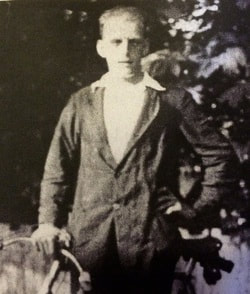
Bill was selected to ride in the 1932 Los Angeles Olympic Games. This was during the great depression, the team was small, so Bill was called upon to compete in the 4000m team pursuit, the 1000m and the 100km road race (actually a time trial) all within the space of four days. Together with Frank Southall, Ernie Johnson and Charlie Holland, Bill won a Bronze Medal in the team pursuit. He came 4th in the 1,000m and 19th in the 'Road race'. All in the in the space of four days, or as Bill later put it with a smile, 'Three for the price of one'.
‘I was pleased with the Bronze medal but I cannot say I was anyway near to tears. I had experienced success quite often in National competition and coming third is really a consolation prize.’ Bill received a heroes welcome upon his return to Poole, he had brought the town to the worlds attention, the Mayor presented him with an illuminated address at the council's meeting later in the year. Read about cycling at the 1932 Los Angeles Olympic Games in my previous blog- '1932 Los Angeles Olympic Cycling' published June 16- use the archives link above.
‘I was pleased with the Bronze medal but I cannot say I was anyway near to tears. I had experienced success quite often in National competition and coming third is really a consolation prize.’ Bill received a heroes welcome upon his return to Poole, he had brought the town to the worlds attention, the Mayor presented him with an illuminated address at the council's meeting later in the year. Read about cycling at the 1932 Los Angeles Olympic Games in my previous blog- '1932 Los Angeles Olympic Cycling' published June 16- use the archives link above.
In 1933 Harvell lead the Poole Wheeler's team (Norman Barnes, Ray Cleal and Ernie Hollywood) to victory in the National Team Pursuit Championship at Herne Hill.
In 1934 he won a Bronze medal 10 mile Scratch at the British Empire Games whose track events were held in Manchester.
Poole Wheelers Club Run 1933. Top row (L to R) unknown, Reg Mullins, Aubrey Jenkins, Ernest Bridle, George Butler, Cyril Crouch. Middle row- Harold Crib, Bill Middle, George Butler, Percy Old, Doris Maddox, Topsy Emery (later rode in the Bournemouth Arrows Ladies Team with Marguerite Wilson), Kit Turner. Bottom row - Bill Harvell, Jack Hetherington, Ted Cake, Walter Paget.
In 1935 he returned to his native Hampshire and his original club, the Southampton Wheelers cc, his last competitive ride was at the 1939 Boscombe Carnival grass track meeting. Bill had been a Poole Wheeler during the peak of his glittering career, a life member, he always took an interest in his old club and in the early 1970s returned to Poole Park to ride a lap of honour.
Bill ran a bike shop in Hilsea near Portsmouth for 37 years, from 1937 until 1974. He specialised in lightweight racing bikes, in particular Rotrax. Described as warm hearted, interesting and welcoming he did valuable work in bringing along youngsters who showed promise in the sport.
In 1984 he was interviewed by a local newspaper. Age 76, Bill was still going out for an occasional ride along the seafront from his home in Southsea. In his a flat he was surrounded by mementos of his glittering cycling career . Among the most cherished were the Olympic Bronze and a British Empire Games medals, saved from the blaze that sadly destroyed the Hilsea bicycle shop in 1974. He died in his sleep a year later age 77.
I would like to acknowledge and thank the following people for help in preparing this article:
George Bolton, Roger Watts, Don Booth, Eric Watts.
George Bolton, Roger Watts, Don Booth, Eric Watts.
